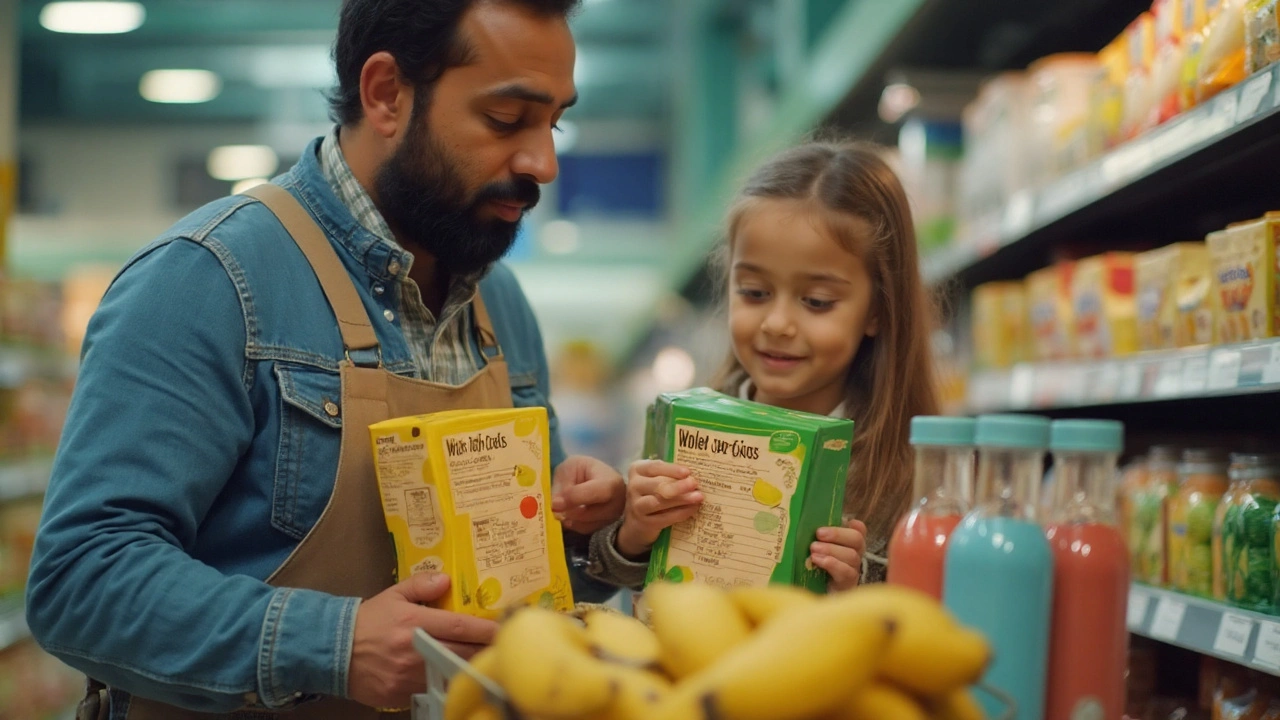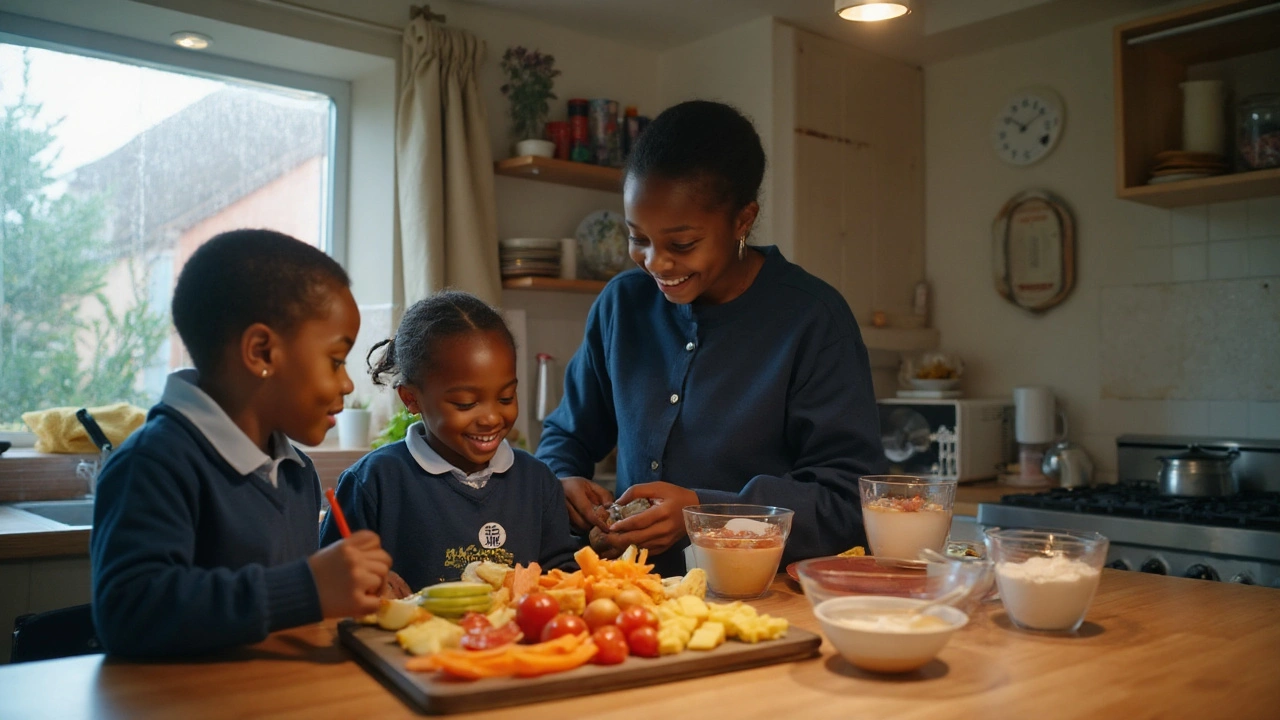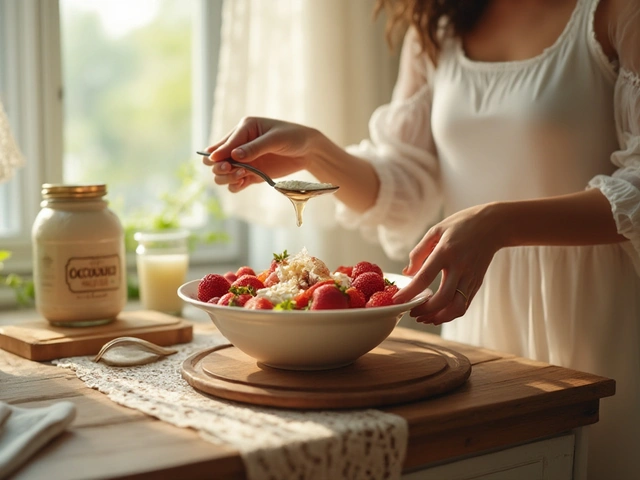Snacks aren’t side characters in a kid’s day-they’re the plot twist that makes or breaks energy, mood, and learning. In the U.S., national survey data show children can get roughly a quarter of their daily calories from snacks. That means snack time quietly carries big nutritional weight. Done right, it tops up growth nutrients, keeps blood sugar steady, and cuts chaos at dinner. Done wrong, it sets off sugar highs, meltdowns, and nutrient gaps.
Here’s the bottom line upfront:
- Kids need steady fuel every 2.5-4 hours; snacks bridge the gaps without spoiling meals when portioned and timed well.
- Pair carbs with protein, fiber, or fat to steady energy (think apple + peanut butter, yogurt + berries, cheese + whole-grain crackers).
- Limit added sugars; aim for less than 6 grams per snack and under 25 grams per day for ages 2-18.
- Most kids do best with 1-3 snacks per day depending on age, appetite, and activity.
- Prep beats willpower: a visible, grab-and-go snack setup nudges better choices with zero nagging.
Why Snacks Matter More Than You Think
Think of snacks as mini-meals with a job to do. The job? Keep brains focused, bodies growing, and moods level between breakfast, lunch, and dinner. The science is practical: young kids have smaller stomachs and faster burn rates. Teens hit rapid growth spurts and often burn through calories with sports and long school days. Without thoughtful snacks, they miss key nutrients and end up ravenous-cue the 4 p.m. pantry raid.
Balanced snacks steady blood sugar. When a snack is mostly refined carbs (juice, chips, candy), glucose spikes then crashes, leading to crankiness and brain fog. Pair that carb with protein, fiber, and healthy fat, and you slow digestion. Energy lasts. Attention holds. Teachers notice the difference at 2 p.m., and so do you at homework time.
Snacks can lift overall diet quality. The USDA Dietary Guidelines for Americans 2020-2025 call out shortfalls in fiber, potassium, calcium, and vitamin D for many kids. Smart snacks-fruit, dairy or fortified alternatives, nuts and seeds, beans, whole grains, veggies with dips-quietly fill those gaps.
There’s also appetite training. Structured snacks help kids arrive at meals hungry but not frantic. That’s the sweet spot where new foods are more likely to get tasted. As a mom, I’ve learned that a 3 p.m. snack with protein defuses the “I’m starving” chorus and keeps dinner civil. My spouse, Patrick, is a repeat offender at our snack bin, which tells you it works for adults, too.
Sports? Snacks are fuel strategy. A pre-practice carb + protein snack boosts output; a post-practice option with protein helps repair muscles. Even for non-athletes, an after-school snack with fiber and protein makes homework and patience go smoother.
“Children ages 2 to 18 should consume less than 25 grams (6 teaspoons) of added sugars per day.” - American Heart Association (AHA)
The AAP (American Academy of Pediatrics) supports 2-3 snacks per day for younger kids, with planned times and portions to avoid grazing. The CDC’s nutrition surveillance backs the idea that consistent, nutrient-dense snacks improve diet quality. The Dietary Guidelines say no added sugars for kids under age 2. These aren’t fads-they’re guardrails that save you from guesswork.
| Age | Typical Snacks/Day | Snack Calories (each) | Protein Target (each) | Fiber Goal (day) | Added Sugar (day) |
|---|---|---|---|---|---|
| 12-24 months | 2-3 | 60-100 | 2-3 g | ~19 g | 0 g (avoid added sugars) |
| 2-5 years | 2-3 | 100-150 | 3-5 g | 19-25 g | < 25 g |
| 6-12 years | 1-2 | 120-200 | 5-10 g | 25-31 g | < 25 g |
| 13-18 years | 1-2 (+sports) | 150-300 | 10-15 g | 26-38 g | < 25 g |
Notes: Fiber goals are Adequate Intake targets from the National Academies. Protein per snack is a practical aiming point, not a strict rule. Active kids and teens may need larger snacks on practice days.
So yes, healthy snacks for kids aren’t “nice-to-have.” They’re the scaffolding that holds up the day.

How to Build, Time, and Portion Snacks (Without Overthinking It)
Here’s a simple blueprint that works across ages and schedules.
Rule of thumb: P + P + F. That’s Produce + Protein (or healthy fat) + Fluid.
- Produce: fruit or veg (fresh, frozen, dried without added sugar, or canned in water).
- Protein/Healthy fat: yogurt, cheese, eggs, beans/hummus, nuts/seeds or butters, edamame, tuna/salmon packets, tofu, or a quality bar with real food ingredients.
- Fluid: water first; milk or fortified nondairy alternative if needed for calcium/vitamin D.
Step-by-step snack build:
- Start with a produce anchor: apple slices, clementine, carrot sticks, snap peas, frozen mango, cucumber coins.
- Add protein or fat: peanut butter, string cheese, Greek yogurt, hummus, cottage cheese, trail mix, roasted chickpeas.
- Layer fiber or whole grains: whole-grain crackers, oats, popcorn, chia pudding, whole-wheat pita.
- Pour water. Flavor it with oranges or berries if that helps.
Timing that prevents grazing:
- Space meals/snacks 2.5-4 hours apart.
- If dinner is within 90 minutes, keep the snack very small (think: a banana or a few nuts).
- For afternoon sports, aim for a snack 45-60 minutes beforehand with 15-30 g carbs + 5-10 g protein. After practice, offer 10-20 g protein + carbs.
Portion sanity checks:
- Toddler: 1-2 tablespoons of each item per year of age is a safe starting point.
- Elementary: target 100-200 calories, 3-6 g protein, 2-4 g fiber.
- Teens: 150-300 calories, 8-15 g protein, 3-6 g fiber; more on heavy training days.
Label decoder (fast):
- Added sugar: aim < 6 g per snack serving. Under age 2? Keep it at 0 g.
- Fiber: look for ≥ 3 g per serving for older kids; ≥ 2 g for younger.
- Protein: ≥ 5 g is useful staying power.
- Ingredients: short, recognizable list; whole grains up front; nuts/seeds/legumes feature prominently; avoid artificial sweeteners for young kids.
- Sodium: keep most snacks < 200 mg.
Pitfalls to dodge:
- Juice and fruit snacks aren’t fruit. Offer whole fruit or, if needed, 100% juice capped at small portions.
- Granola bars can be candy bars in disguise. Check added sugars and protein.
- “Veggie” chips rarely deliver real veggies. Choose real vegetables with a dip kids like.
- Constant grazing kills dinner appetite. Keep snack times predictable.
- Sports drinks are for endurance events, not P.E. class.
Heuristics that make life easier:
- Two-by-two rule: offer two food groups and two textures (e.g., crunchy carrots + creamy hummus) to keep it interesting.
- Color check: aim for two colors on the plate. It nudges variety without a lecture.
- 5-minute prep cap: if it takes longer, it’s a weekend snack, not a school day one.
- Repeat wins. Kids love predictability; rotate 5-7 hits and change the fruit/veg.

The Real-Life Snack Playbook: Ideas, Checklists, FAQ, and Fixes
Let’s make this actionable. Here are ideas organized by age, setting, and constraint.
Fast ideas by age:
- Toddlers (watch choking hazards; serve age-appropriate sizes): diced soft fruit + whole-milk yogurt; mashed avocado on toast fingers; pea-sized cheese cubes + halved blueberries; hummus on soft tortilla strips; oatmeal with chia and mashed banana.
- Elementary: apple slices + peanut butter; cottage cheese + pineapple; whole-grain crackers + cheese; carrots/cucumbers + ranch or hummus; yogurt + granola (low sugar).
- Teens: turkey + cheese roll-ups in a whole-wheat wrap; Greek yogurt + frozen berries + walnuts; microwave edamame + sea salt; tuna packet + whole-grain crackers; smoothie with milk, frozen fruit, oats, and peanut butter.
Lunchbox and school-safe swaps (nut-free when required):
- Sunflower seed butter or soy butter instead of peanut butter.
- Roasted chickpeas or edamame instead of nut mixes.
- Whole-grain crackers + cheese stick or hummus cup.
- Fruit + yogurt tube (look for lower added sugar) + water.
- DIY trail mix: pumpkin seeds, whole-grain cereal, unsweetened coconut chips, raisins.
Pre- and post-sport combos:
- 45-60 min pre: banana + peanut butter; small turkey wrap; yogurt + granola; oat bar with nuts/seeds.
- Post: chocolate milk or fortified alternative; Greek yogurt + fruit; egg + toast; tuna/cracker kit; cottage cheese + peaches; smoothie with 15-20 g protein.
Travel and car snacks:
- Single-serve hummus + pretzel thins + mini peppers.
- Shelf-stable milk or milk alternative boxes + whole-fruit.
- Roasted chickpea packs; applesauce pouches (no added sugar).
- Jerky (lower sodium) + clementine + water.
Budget-friendly staples (price-savvy):
- Oats, bananas, carrots, popcorn kernels, dried beans, eggs, store-brand yogurt, seasonal fruit, frozen vegetables, canned salmon/tuna, store-brand whole-grain crackers.
- Cook once, snack twice: make a pot of beans or batch of pancakes; freeze portions.
Make a no-brainer snack station:
- Fridge bin: washed grapes, carrot sticks, snap peas, yogurt, cheese sticks, deli turkey, hummus cups.
- Pantry bin: whole-grain crackers, popcorn, fruit cups in water, roasted chickpeas, shelf-stable milk, nut/seed butter squeeze packs.
- Rules on the bin: pick one from fridge + one from pantry + water. Done.
Simple decision tree:
- Is it within 90 minutes of a meal? If yes, offer fruit or veg only, or very small protein.
- Is energy crashing? Add protein + fiber.
- Is practice in an hour? Choose carb + protein, low fat, easy to digest.
- Is bedtime near? Choose protein + complex carb (small portion) to steady blood sugar overnight: small yogurt + berries, or toast + peanut butter.
Label cheat-sheet to save you time:
- Bars: ≤ 6 g added sugar, ≥ 5 g protein, ≥ 3 g fiber, nuts/seeds first 3 ingredients.
- Yogurt: ≤ 6-8 g added sugar per cup for kids; Greek styles deliver more protein.
- Crackers: whole grain as first ingredient; ≥ 2 g fiber/serving; sodium < 200 mg.
- Trail mix: nuts/seeds + unsweetened dried fruit; chocolate is fine in modest amounts.
Weekly planning in 10 minutes:
- Pick 5 snack combos for the week (repeat favorites).
- Shop for 2 fruits, 2 veggies, 2 proteins, 1 whole-grain.
- Wash and chop once-Sunday or the night you have energy.
- Set up the bins; label them if your kids like visuals.
- Refill midweek with frozen fruit/veg to keep waste low.
Mini-FAQ
- How many snacks should my child have? Younger kids often need 2-3; older kids and teens usually 1-2. Use appetite and schedule to guide you.
- Are carbs bad? No. Go for minimally processed carbs with fiber-fruit, veg, oats, whole grains-and pair with protein/fat.
- Do kids need snacks before bed? Not always. If dinner was early or light, a small protein + complex carb snack can help sleep.
- What about picky eaters? Keep offering a safe food + a tiny taste of a new food. No pressure. Predictable exposure works better than bribes.
- Is organic required? Not required. If budget allows, great. If not, rinse produce well and keep variety high.
- Nut allergies? Use seeds (sunflower, pumpkin), soy butter, chickpeas, lentils, dairy or fortified alternatives for protein and fat.
- Can snacks cause cavities? Sticky, sugary snacks and constant sipping are the issue. Choose whole foods, keep water handy, and brush.
Red flags that a snack routine needs a tweak:
- Meltdowns or “hangry” behavior at the same time daily. Adjust timing and add protein/fiber.
- Chronic dinner battles. Move the afternoon snack earlier or shrink it.
- Frequent tummy aches. Watch for too much juice/sugar or dairy sensitivity; check portions and timing.
Evidence touchpoints (no links, straight to the sources):
- USDA Dietary Guidelines for Americans 2020-2025: limits on added sugars, nutrient shortfalls, and child feeding guidance.
- American Academy of Pediatrics: structured meals/snacks, no added sugar under age 2, sugar-sweetened beverage guidance.
- American Heart Association: less than 25 g added sugar/day for ages 2-18.
- CDC (NHANES): snack contributions to daily energy intake and patterns in U.S. children.
Troubleshooting by scenario
- Time-crunched mornings: pre-portion snacks the night before; set the fridge/pantry bins; keep “no prep” options like cheese sticks, fruit, roasted chickpeas.
- Super active athletes: add an extra carb + protein snack on practice days; pack portable options like tuna packs, jerky, yogurt, bananas, oat bars.
- Picky eater plateau: pair one favorite with one new item; serve it family-style; involve your child in choosing the fruit or dip to boost buy-in.
- Tight budget: buy store brands, use frozen fruit/veg, pick in-season produce, make a big batch of beans for hummus/roasted chickpeas.
- School nut bans: swap to sunflower/soy butter, roasted chickpeas, edamame, dairy or soy yogurts, seed mixes.
- Food allergies: lean on safe proteins (seeds, legumes, dairy or fortified alternatives, meats, tofu) and check labels every time-recipes change.
Quick snack ideas you can copy this week:
- Apple + peanut or sunflower seed butter + water.
- Greek yogurt + frozen berries + sprinkle of oats.
- Whole-grain crackers + cheese + grapes.
- Hummus + pita + cucumbers.
- Cottage cheese + pineapple + popcorn (air-popped) on the side.
- Edamame + orange slices.
- Hard-boiled egg + toast + cherry tomatoes.
If you only remember three things: plan snacks like mini-meals, pair carbs with protein/fiber, and keep water in the routine. Do that, and you’ll notice smoother afternoons, fewer dinner standoffs, and kids who actually feel good between meals.






